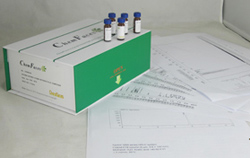Hot Products



| Catalog No. | Information |
| CFN98584 | Denudatine Denudatine has effects on action potential of ventricular fibers and has inhibition on arrhythmogenic action of aconitine. |
| CFN96880 | De-O-methyllasiodiplodin De-O-methyllasiodiplodin exhibits radical scavenging, moderate antibacterial, and potential anti-inflammatory effects, it shows moderate suppression effects on induced NO production. De-O-methyllasiodiplodin effectively lowers the blood glucose level in db/db mice possibly via ameliorating the expression of obesity-related pro-inflammatory cytokines, highlighting the potential of the marine natural product as a drug lead for the treatment of metabolic disorders. |
| CFN90518 | Deoxyandrographolide Deoxyandrographolide promotes glucose uptake through glucose transporter-4 translocation to plasma membrane in L6 myotubes and exerts antihyperglycemic effect in vivo. |
| CFN96918 | Deoxyarbutin Deoxyarbutin possesses a potent ability in skin lightening and antioxidation with less melanosome cytotoxicity, it is an effective hypopigmentation agent, it is widely used in skin lighting. Deoxyarbutin can combate tumour in vitro and in vivo by inhibiting the proliferation and metastasis of tumour via a p38-mediated mitochondria associated apoptotic pathway. |
| CFN97212 | Deoxyartemisinin Deoxyartemisinin can inhibit microbial growth and reproduction,and is therefore likely to influence biochemical reactions in soils. |
| CFN99798 | Deoxycholic acid Deoxycholic acid is a strong promoter of hepatocarcinogenesis with possible complete carcinogenicity in the liver and promotion potential for tumor development in the small intestine. Loss of deoxycholic acid-induced EGFR/Ras/MAPK pathway function potentiates deoxycholic acid-stimulated FAS-induced hepatocyte cell death via a reduction in the expression of c-FLIP isoforms. |
| CFN97764 | Deoxyelephantopin Deoxyelephantopin has anti-inflammatory, hepatoprotective, and wound healing activities; it also has antitumor activity, by inhibiting metastatic, inducing apoptosis, modulating oxidative stress , STAT3/p53/p21 signaling, MAPK pathway, PI3k/Akt/mTOR pathway, caspase cascades, and ROS . |
| CFN90484 | Deoxynojirimycin hydrochloride 1-Deoxynojirimycin hydrochloride shows inhibitory activity against α-glucosidases, inhibitors of α-glucosidase are promising candidates for the development of antitype II diabetics and anti-AIDS drugs. |
| CFN99888 | Deoxypodophyllotoxin Deoxypodophyllotoxin shows cytotoxic , antineoplastic, antitumor, insecticidal, anti-angiogenic, vascular disrupting, insecticidal, antiviral, and anti-inflammatory activities. Deoxypodophyllotoxin induces G2 /M cell-cycle arrest followed by apoptosis through multiple cellular processes, involving the activation of ATM, upregulation of p53 and Bax, activation of caspase-3 and -7, and accumulation of PTEN resulting in the inhibition of the Akt pathway. Deoxypodophyllotoxin maybe applicable to treat hyperpigmentation, it decreases UV-induced skin pigmentation of brown guinea pigs. |
| CFN92024 | Deoxyshikonin Deoxyshikonin and dodecyl gallate show significantly synergic antimicrobial activity with penicillin in vivo and in vitro, and can effectively reduce nasopharyngeal and lung colonization caused by different penicillin-resistant pneumococcal serotypes. Deoxyshikonin exerts very good radical scavenging activities toward ABTS+ but shows moderate inhibition of DPPH·, and shows cytotoxic activities. Deoxyshikonin may be a new drug candidate for wound healing and treatment of lymphatic diseases. |